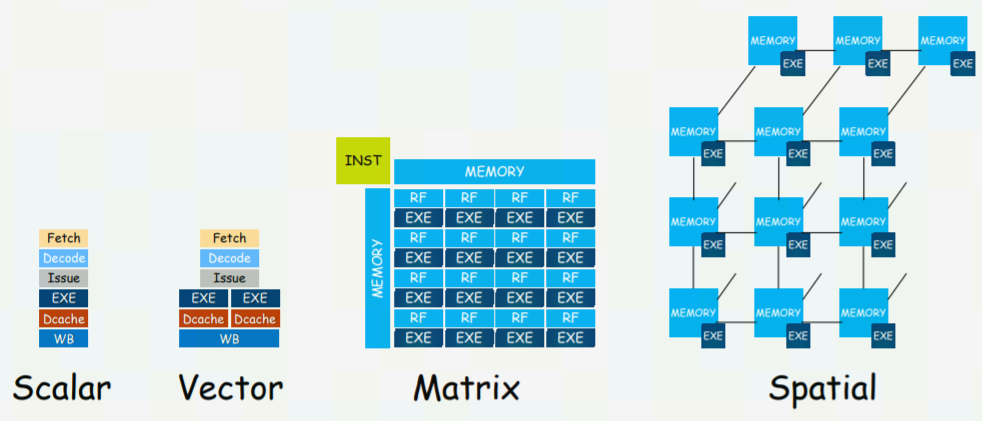姚伟峰
Landmark
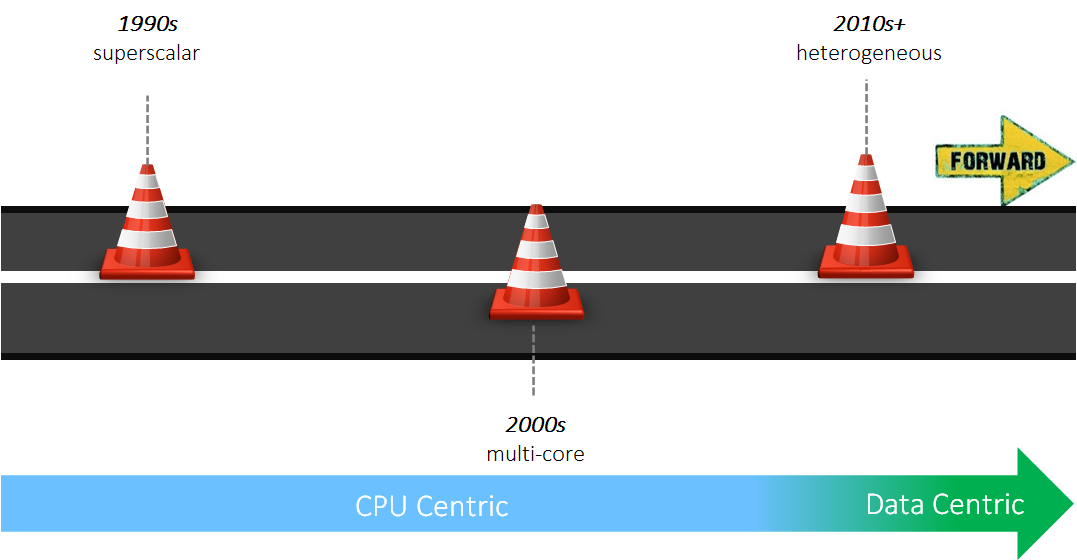
Superscalar时期(1990s)
超标量时期主要关注single core的性能,主要使用的方法有:
ILP(Instruction Level Parallelism)
ILP顾名思义就是挖掘指令性并行的机会,从而增加指令吞吐。指令吞吐的度量是: IPC(Instructions Per Cycle)即每个clock cycle可以执行的指令数。在未做ILP的时候 IPC = 1。
增加IPC主要通过pipeline技术来完成(如下图)。Pipeine技术把指令的执行过程分成多个阶段(stages),然后通过一个同步clock来控制,使得每一拍指令都会往前行进到pipeline的下一个阶段,这样理想情况下可以保证同一个cycle有 条指令在pileline内,使得pipeline的所有stage都是忙碌的。
条指令在pileline内,使得pipeline的所有stage都是忙碌的。 称为pipeline的深度(depth)。
称为pipeline的深度(depth)。

下图是RISC-V的标准pipeline,它的 ,分别为:取指(Instruction Fetch, IF),译指(Instruction Decode, ID),执行(Execute, EX),访存(Memory Access, Mem),回写(Write Back, WB)。其中IF和ID称为前端(Front End)或者Control Unit,执行/访存/回写称为后端(Back End)或者广义Arithmetic/Logical Unit(ALU)。
,分别为:取指(Instruction Fetch, IF),译指(Instruction Decode, ID),执行(Execute, EX),访存(Memory Access, Mem),回写(Write Back, WB)。其中IF和ID称为前端(Front End)或者Control Unit,执行/访存/回写称为后端(Back End)或者广义Arithmetic/Logical Unit(ALU)。
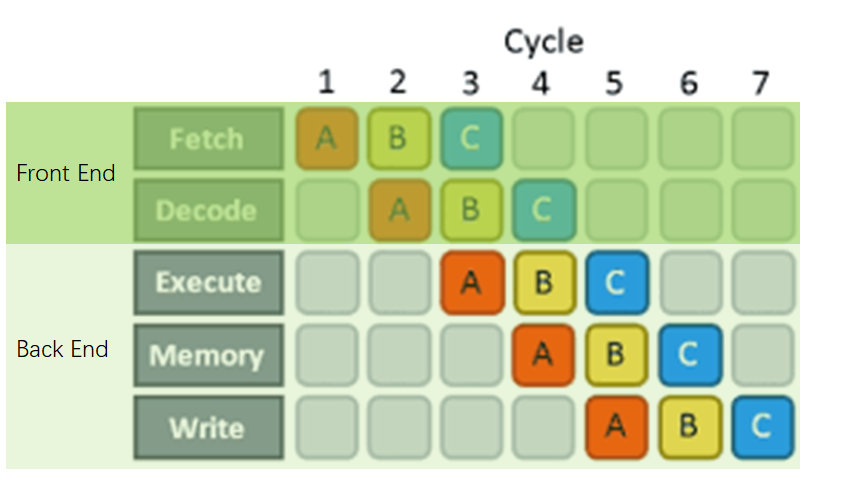

有了pipeline,可以通过增加pipeline width的方式提高指令并行度,即使得pipeline可以在同一个cycle取、译、发射(issue, 发射到execution engine执行)多个指令的方式来达成ILP。物理上,需要多路ID/IF以及多个execution engines。如果一个core在一个cycle最多可以issue  条指令,我们就叫这个架构为m-wide的multi-issue core。Multi-issue core也叫superscalar core。
条指令,我们就叫这个架构为m-wide的multi-issue core。Multi-issue core也叫superscalar core。
下图为x86 SunnyCove core(Skylake的core)示意图,可以看到,它有4个计算ports(即execution engines),我们可以称它为4-wide multi-issue core,且它的最大可达IPC为4。
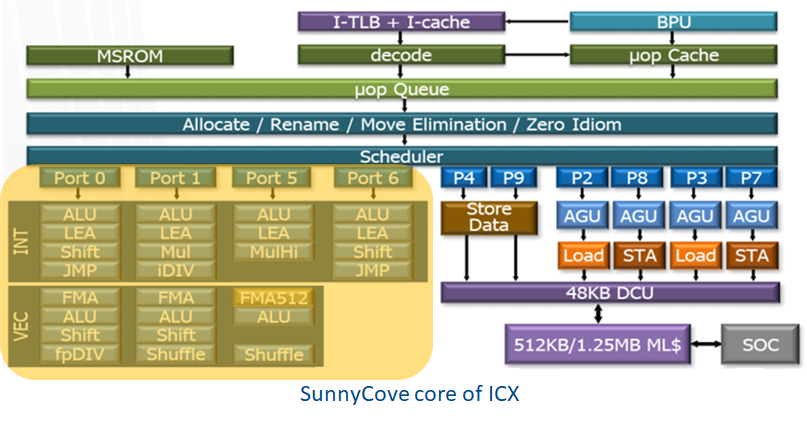
DLP(Data Level Parallelism)
提高数据并行度的主要方式是增加每个execution engine单clock cycle能处理的数据数来达成。传统的CPU一个clock只能处理一个标量的运算,我们叫它scalar core。增加DLP的方式是使得一个clock能处理一个特定长度的vector数据,这就是vector core。目前vector core主要通过SIMD(Single Instruction Multiple Data)技术来实现数据并行,如ARM的NEON,X86的SSE、AVX(Advanced Vector eXtensions)、AVX2、AVX-512,以及GPU的SIMT(Single Instruction Multiple Data)的execution engine都是SIMD。
下图SunnyCove core的port 5有一个AVX-512的FMA512(512-bit Fused MultiplyAdd) 它可以带来16个FP32乘加运算的DLP。
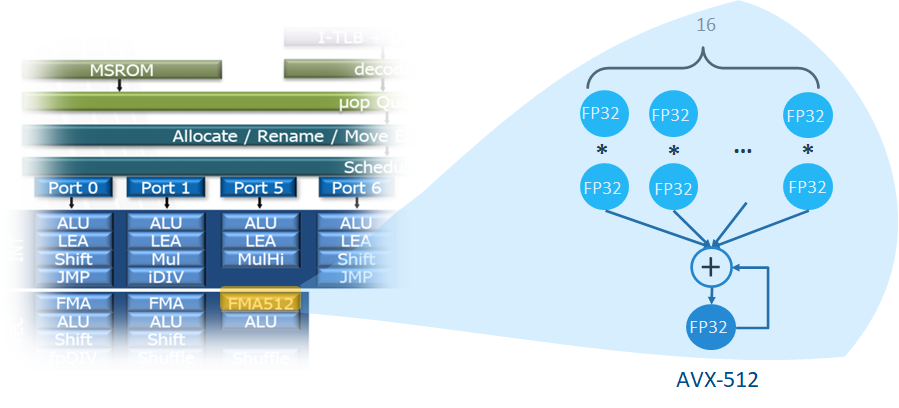
Heterogeneous Parallelism
这一时期,我们也能依稀看到异构并行的萌芽,体现在标量和向量的异构并行上。下图就体现出标量和向量的并行。
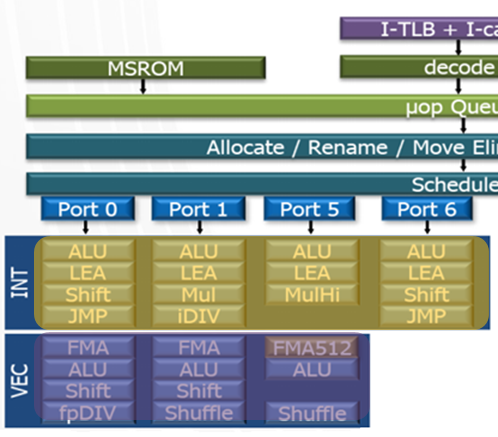
Multi Core时期(2000s)
多核时期在继续抠ILP、DLP的同时,慢慢开始重视TLP(Thread Level Parallelism)。主要想法是通过组合多个同构(homogeneous)核,横向扩展并行计算能力。
TLP(Thread Level Parallelism)
Physical Multi-Core
Physical Multi-Core就很简单了,就是纯氪金,对CPU和GPU而言都是堆核,只不过GPU把核叫作SM(Streaming Multiprocessor, NV),SubSlice(Intel)或Shader Array(AMD)。
下图是x86 Icelake socket,它有28个cores。

下图是NV A100对应的GA100 full chip,它有128个cores(SMs)。
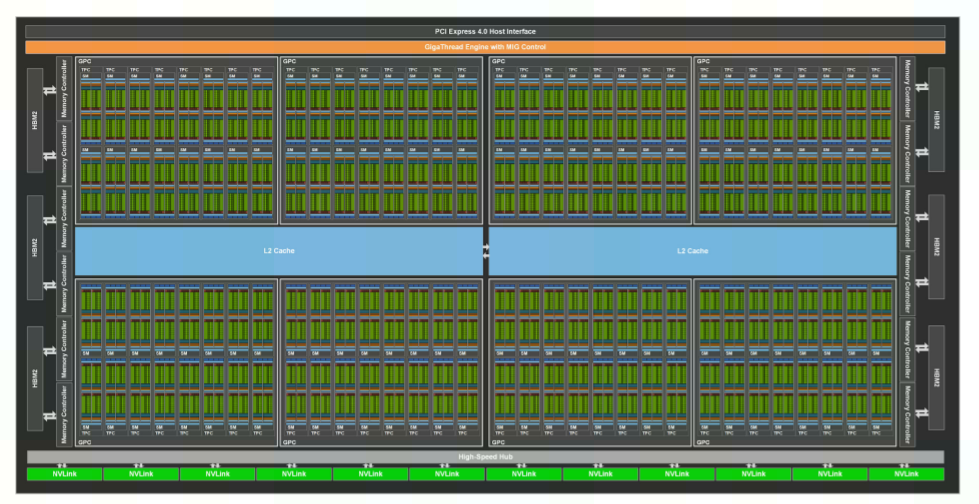
Hardware Threading
相比Physical Multi-Core,Hardware Threading就是挖掘存量了。它的基本假设是现有单程序pipeline里因为各种依赖会造成各种stall,导致pipeline bubble,且想仅靠从单个程序中来fix从而打满pipeline利用率比较困难,所以考虑跨程序挖掘并行度。基于这个假设,一个自然的想法就是增加多个程序context,如果一个程序stall了,pipeline就切到另一个,从而增加打满pipeline的概率。示意图如下。
CPU:
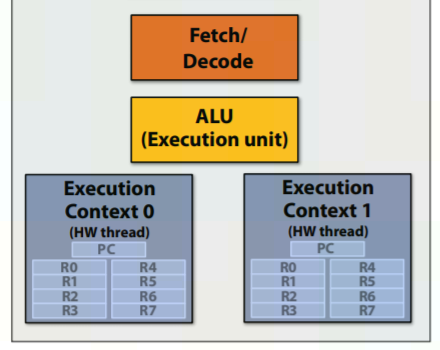
GPU:
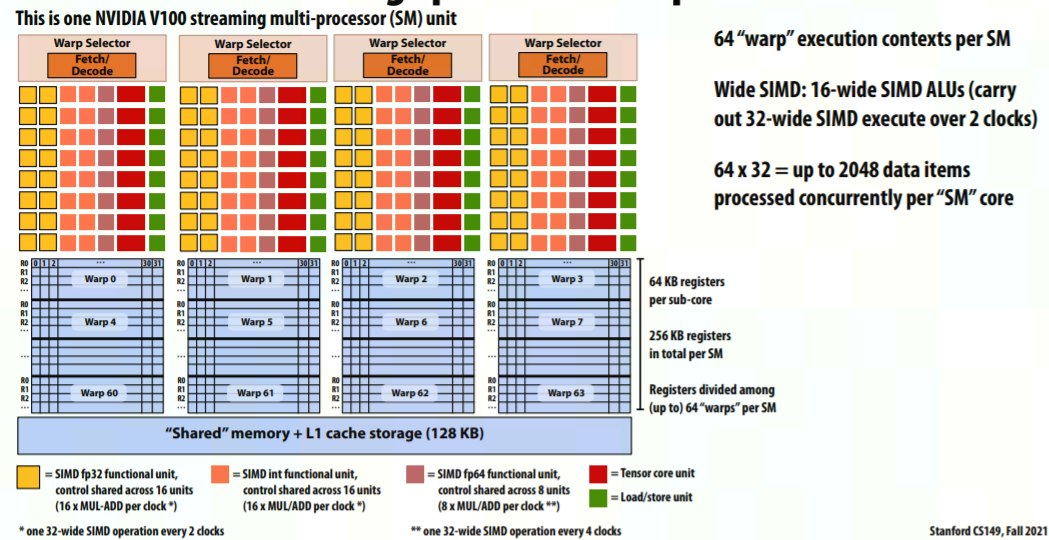
这就可以看出为啥叫threading了,就是不增加实际pipeline,只增加execution context的白嫖,:),这是threading的精髓。跟software threading不一样的地方是,这个execution context的维护和使用是hardware做的,而不是software做的,因此叫hardware threading。
因为有多个contexts对应于同一个pipeline,因此如何Front End间如何issue指令也有两种方式:
-
SMT(Simultaneous Multi-Threading)
Each clock, the pipeline chooses instructions from multiple threads to run on ALUs。典型的SMT就是Intel X86 CPU的Hyper Threading Technology(HT or HTT),每个core有2个SMT threads;以及NV GPU的warp。 -
IMT(Interleaved Multi-Threading)
Each clock, the pipeline chooses a thread, and runs an instruction
from the thread on the core’s ALUs. Intel Gen GPU采用的SMT和IMT的混合技术。
Heterogeneous Computing时期(2010s+)
由于application对算力(Higher Computation Capacity)和能效(Better Power Efficiency)的需求越来越高,体系架构为了应对这种需求发生了methodology的shift,从One for All走向Suit is Best。这是需求侧。
而在供给侧,GPU的成功也侧面证明了Domain Specific Computing的逐渐成熟。
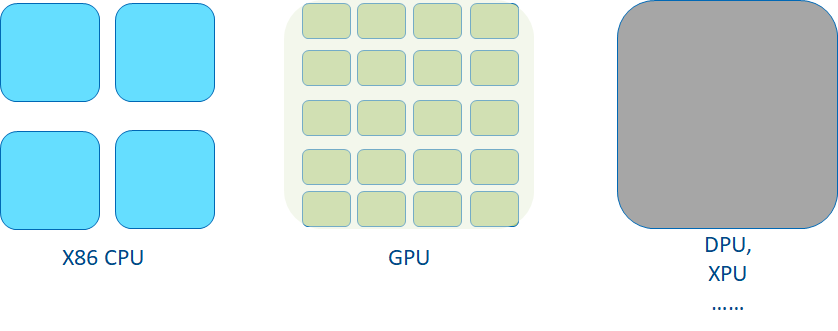
对software productivity而言,需要有两个前提条件:
-
Unified Data Access
这个OpenCL 2.0的SVM (Shared Virtual Memory)和CUDA的UVM(Unified Virtual Memory)有希望。硬件上coherency-aware data access硬件如CXL可以从性能角度support这个。 -
Unified Programming Model
需要类C/C++的且支持异构计算的统一编程语言,这个有CUDA,OpenCL以及DPC++。
异构计算的题中之意是:Use best compute engine for each workload by re-balancing ILP & DLP & TLP,最终计算能力是3者的组合:


目前最常见的异构计算是CPU和GPU的异构计算,CPU作为latency machine代表, GPU作为throughput machine的代表,二者各有所长。
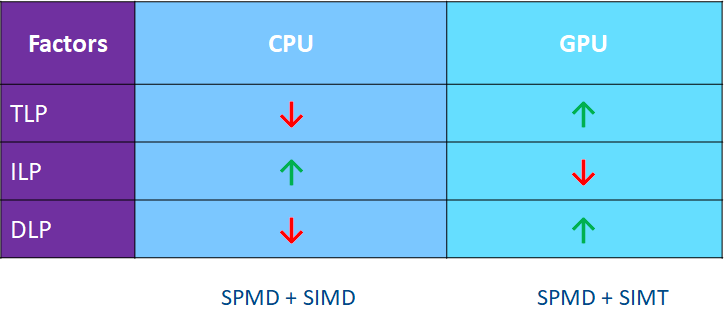
CPU Micro-Architecture Characteristics
-
TLP
tens of cores, each with 2 hardware threads; -
ILP
4 compute ports w/ OoO(Out of Order) issue -
DLP
SIMD width supported by Increased $ bandwidth

GPU Micro-Architecture Characteristics
-
TLP
hundreds of cores, each with many(e.g. 32) hardware threads;
simple and efficient thread generation/dispatching/monitoring -
ILP
2~3 compute ports, mainly in-order issue -
DLP
Wider SIMD width, plus large register files reduce $/memory bandwidth needs and improve compute capability and efficiency
随着算力和能效的要求越来越高,除了挖掘冯-诺伊曼体系内的异构计算机会外(如CPU+GPU异构, CPU+ASIC异构等)。大家还开始revisit其他体系结构,寻找cross体系结构的异构机会,如最近一段时间大家讨论比较多的dataflow architecture或者spatial computing。路是越走越宽了!
